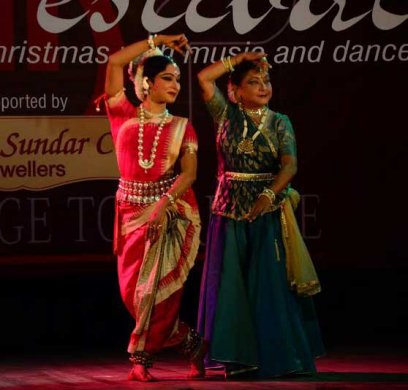
|   |

|   |
Duet by Saswati Sen and Sujata Mohapatra in Sur Festival - Nita Vidyarthi e-mail: nitavidyarthi@gmail.com Photo courtesy: Sur March 9, 2016 Two very talented and efficient young musicians, Debapriya Adhikary (vocalist) and Samanwaya Sarkar (sitarist), both disciples of Girija Devi, began the Sur Festival in 2014 to spread the arts. Essentially a music and dance festival, the two years saw the top musicians and dancers entertain the connoisseurs, select and appreciative audience. ‘Sublime Urge to Rejoice’ (SUR) Festival aims to extend their boundaries to theatre, films, literature and sports, to attract people from all walks of life. The well organised three day festival this year presented by Fogg at the G.D. Birla Sabhagar, Kolkata, was inaugurated by Girija Devi, and opened with a vocal recital by Sanhita Nandi. However, the attraction of the evening was the stately Kathak-Odissi duet by the acclaimed dancers Saswati Sen, the foremost disciple of Pandit Birju Maharaj, and Sujata Mohapatra, the star disciple and daughter-in-law of Guru Kelucharan Mohapatra. Naturally both need no further introduction.  The magic of the rare ‘jugalbandi’ did not rely on dance styles but resulted from the perfect coordination of forces, both aesthetic and mechanical, apart from a thorough understanding, a solid training of the dance form and virtuosity. What style is, is not for words to define! With distinguished musicians and vocalists in live accompaniment, the recital was bound to be gratifying. The invocation ‘Pranati’ began with the sound of dhak (drums from Bengal) and Shankhadwani (blowing of a conch shell), in celebration of the three iconic pairs, Shiva-Parvati, Rama-Sita and Vishnu-Lakshmi. The duo stood side-by-side, swayed in their own still points at a samapada position with the music. Saswati executed a mild chakkar while Sujata took a neat bhramari. Then both separated and stood diagonally to each other and broke into a duet in their respective idioms with Rupak Paridha’s vibrant singing “Om Sarveswaraya, Om Bidiswaraya, Om Gangeshwaraya.... Sriman Mahadevaya Namoh.” Saswati in lasya and Sujata in the tandava did full justice to the sloka. The Rama-Sita piece “Raghuvamsha Tilakam” saw Sujata as Rama and Saswati in Sita’s emotionally involved execution, beginning with their wedding. “Shantakaram Bhujagashayanam” was the obvious choice for the Vishnu-Lakshmi item with Sujata in the anantasayanam posture with the left hand in the Sarpasira mudra. The choreography of this final item was an interesting combination of nritta (pure dance) of the two dance forms adorned with Pallavi from the Odissi repertoire by Sujata and steady chakkars by Saswati, mellifluously supported by the efficient musicians. The duets were spaced by rewarding solos. In the Durga Stuti “Jatajutta samayukta,” Sujata’s knowledge, vital bearing and radiance portraying the powerful goddess were commendable. The elaboration of “Atasipushpa barnava” thrice in three different compositions was soaked in mystic richness while as ‘Mahisasuramardini’ highlighting the weapons, she was highly dignified even though too much red jarred. It was time to watch with wonderment the wizardry of Saswati Sen playing with rhythms effortlessly in her nritta in taal Dhamar, 14 beats. An immensely versatile dancer, she is an expert of the Lucknow gharana imbued with the true style of her mentor. Her treasure trove gradually unfurled her rhythmic virtuosity with ease with “kuch bandishey” (some compositions) with “layaki nowk-jhok.” Nowk-Jhok was it definitely beginning with thaat, “ginti ki-tihai” in tishra jati, then chaturashra followed by a group of “4, 3, 2, 1 ka andaz.” One rarely gets to see such permutations and combinations of beats and Saswati familiarised the audience with the mental sensations produced by rhythm and sound with the help of some paranath, ek andaz laya ki embellished with flourishes of steady, vigorous chakkars encircling the stage. In the scintillating “Sam ki khoj,” the dancer’s expression of “khoj” (hunting) matched to the T with the powerful footwork (tatkaar) and the perfect landing pat on the sam was an unbelievable experience. She concluded her captivating juggle with rhythms with exceptional footwork to some special rhythmic combinations of the gharana like Tihai-Dhamar ka ek andaz in single and double, Sam chhodke tihai ka andaz and delightful Chakkar ka andaz - kuch daharey, kuch ekaharey, finally flagging off with 16 whirling chakkars. And all this was ably supported by the ace tabaliya Shubhankar Banerjee. The jugalbandi concluded with a choreographic piece combining two ashtapadis from Jayadeva’s Gita Govind. Sujata excelled as the anguished Radha who spurns Krishna for spending the night with another nayika in “Rajanijanitaguru jagoraragakashayitamalasanimesham” set to Bhairavi, ektali. Portrayal of “Yahi Madhava” was natural as expected from an artist of such high calibre. Saswati as Krishna pleading for pardon disappointed with mediocre abhinaya. In “Priye Charushile” vocalist Anirban Bhattacharya delighted with his singing and ruled over the abhinaya which lacked depth. “Badasi yadi kinchidapi” too fell short of expectations. However, the concluding Tarana composed by Pandit Birju Maharaj in raga Bhairavi by the duo in the two dance idioms, made up for it all. The success of the recital definitely rested on the powerful support of the musicians Soumya Ranjan Joshi on the flute, Nirmal Nayak on the violin, A Kaelappia on the pakhawaj, and Chandrachur Bhattacharya on the sitar with the already mentioned Odissi vocalist Rupak Paridha and Hindustani vocalist Anirban Bhattacharya. The second and the third evenings saw recitals of tabla by Pandit Kumar Bose, vocal by Debapriya Adikary, sitar by Samanwaya Sarkar and vocal by Pandit Rajan and Sajan Misra. A very rewarding bonus was the captivating vocal-sitar (Gayaki ang) duet by Debapriya and Samanwaya, the two young musicians behind this festival. Dr. Nita Vidyarthi is a regular contributor to The Hindu and the Statesman Kolkata in dance, vocal music and theatre. She is trained in Kathak, Bharatanatyam and Manipuri as well as vocal, semi-classical music and Rabindra Sangeet. A Science communicator, Ph.D. in Polymer Science, Commonwealth Scholar and a retired Professor of Chemistry, Nita devotes most of her time to dance and theatre writing. |